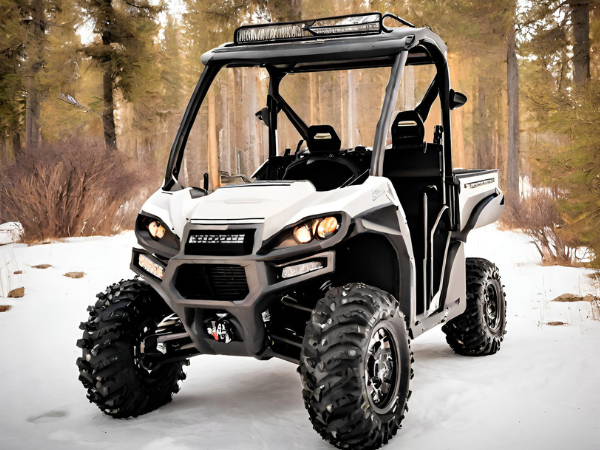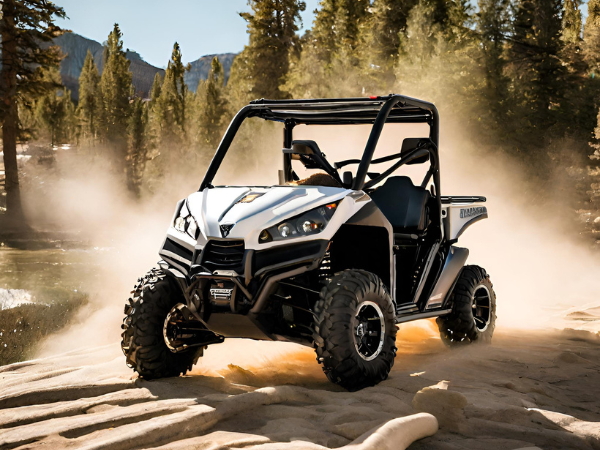The Bennche Bighorn 400 is a mid-sized utility terrain vehicle (UTV) known for its versatility and efficiency, but users report issues with its electrical systems and transmission. Solutions often involve regular maintenance checks and using quality replacement parts.
Exploring the world of off-road adventure requires a reliable vehicle like the Bennche Bighorn 400, a compact yet robust UTV designed to tackle challenging terrain with ease. Its characteristics include a 391cc engine, on-demand four-wheel drive, and a locking differential, making it suitable for various tasks from hunting to farm work.
Despite its strengths, some owners face mechanical setbacks such as electrical glitches and problematic gear shifts. Resolving these issues typically means staying on top of service schedules and seeking assistance from experienced mechanics or dedicated forums. Enthusiasts considering this UTV must weigh its practical benefits against the need for potentially frequent repairs. Offering a balance of power and functionality, the Bighorn 400 remains a popular choice for those needing a multi-purpose UTV.
Characteristics
The Bennche Bighorn 400 is an all-terrain vehicle that combines robustness with agility. Let’s dive into the characteristics that make the Bighorn 400 a worthy contender in the off-road community. From engine specifications to its transmission system, every aspect is designed to enhance the riding experience.
Engine Specifications
The heart of the Bennche Bighorn 400 lies in its engine. Below are the key specs:
- Single-cylinder, four-stroke engine
- Displacement: 391 cc
- Liquid cooling system
- Maximum Speed: 35 to 45 miles per hour (56 to 72 kilometers per hour)
- Horsepower: Delivers robust power for off-road challenges
Dimensions And Weight
The Bighorn 400’s dimensions and weight contribute to its stability and maneuverability:
| Aspect | Measurement |
|---|---|
| Length | 103 inches |
| Width | 57 inches |
| Height | 74 inches |
| Dry weight | 1157 lbs |
Suspension And Braking
Suspension and braking systems are vital for a smooth and safe ride:
- Independent double A-arm front suspension
- Swing-arm rear suspension
- Hydraulic disc brakes for dependable stopping power
Transmission System
The transmission system of the Bennche Bighorn 400 ensures seamless power delivery:
- Automatic CVT (Continuously Variable Transmission)
- Driveline: 2WD/4WD with push-button control
- Reliable shaft drive

Common Problems
Even the most reliable UTVs encounter issues, and the Bennche Bighorn 400 is no exception. Understanding the typical troubles and the right fixes keeps adventures on track. Let’s delve into the Bighorn 400’s common problems.
Issues With Engine Performance
Engine problems can arise from various factors, impacting your ride’s power and reliability. Common symptoms include:
- Hard starts or failure to start
- Unusual noises like knocking or backfiring
- Loss of power
Regular maintenance is key. Check and replace spark plugs and air filters.
Electrical Problems
Electrical issues in the Bighorn 400 typically include:
- Dead batteries
- Dim or non-functioning lights
- Inconsistent start-up
Solutions involve checking wirings and connections, along with ensuring battery health.
Brake And Suspension Issues
The Bennche Bighorn 400’s ride quality can be affected by brake and suspension issues. Look out for:
- Unresponsive or spongy brakes
- Vehicle leaning to one side
- Unusual tire wear
Maintain brakes and check suspension components regularly.
Transmission Problems
Difficulty in shifting gears or strange sounds can point to transmission troubles. Key signs include:
| Problem | Solution |
|---|---|
| Shifting delay | Adjust or replace cables |
| Grinding noise | Inspect and refill transmission fluid |
Proper lubrication and adjustments help avoid costly repairs.
Solutions For Engine Issues
Encountering engine troubles in your Bennche Bighorn 400 can be disheartening. The rugged all-terrain capabilities hinge on a reliable engine. Thankfully, common problems have straightforward solutions. Let’s explore those to keep your Bighorn purring like a kitten and ready for adventure.
Regular Maintenance And Servicing
Think of regular maintenance as your vehicle’s health checkup. It prevents minor issues from escalating. Aim for servicing after every significant outing or as per the manual.
- Check oil levels and quality frequently.
- Clean and adjust the carburetor.
- Inspect the entire engine for signs of wear and tear.
Fuel System Cleaning
Dirt and debris clog the fuel system over time. A clean fuel system ensures smooth operation.
- Drain old fuel. Use fresh, high-quality fuel.
- Clean the fuel pump and replace the filter.
- Ensure the fuel lines are clear of obstructions.
Spark Plug Replacement
Worn spark plugs can lead to starting difficulties. Installing new spark plugs regains engine efficiency.
| Step | Action |
|---|---|
| 1 | Remove and inspect old spark plug. |
| 2 | Replace if corroded or dirty. |
| 3 | Set proper gap and install new plug. |
Air Filter Maintenance
An engines need clean air to breathe. Maintaining the air filter is crucial.
- Check the air filter regularly.
- Clean or replace if dirty.
- Ensure proper filter seating to prevent debris entry.

Troubleshooting Electrical Problems
Troubleshooting electrical problems in your Bennche Bighorn 400 can seem daunting. Yet, by understanding the common issues and their solutions, you can get back to your adventures quickly. Electrical hiccups can prevent your utility vehicle from starting or running at its best. We’ll explore the steps to identify and resolve these electrical woes efficiently. Let’s start with the basics: fuses, wiring, and the battery system.
Checking And Replacing Fuses
Fuses protect your Bighorn’s electrical components. A blown fuse can cause a malfunction in any part of the electrical system. To check, locate your fuse panel and examine each fuse. Look for a broken metal strip inside. If found, replace it with one of the same amperage. Carry spare fuses in your Bennche to fix issues on the go.
Inspecting And Repairing Wiring
Damaged wiring can lead to shorts or incomplete circuits. Begin by inspecting the wiring harness for any visible damage, corrosion, or loose connections. Use dielectric grease on connectors to prevent future corrosion. Secure loose wires with zip ties. In some cases, repairing wiring may require professional assistance.
Testing The Battery And Alternator
- Inspect the battery for corrosion and clean terminals if needed.
- Use a voltmeter to test the battery’s charge; it should read 12.6 volts or higher.
- If the battery is low, charge it and retest. A battery that won’t hold a charge may need replacing.
- Start your Bighorn and test the alternator’s output with the voltmeter; a healthy alternator will produce approximately 14 volts.
By following these essential troubleshooting steps, most electrical issues with your Bennche Bighorn 400 can be identified and resolved.
Addressing Brake And Suspension Issues
The Bennche Bighorn 400 is known for its reliable performance in rough terrains. To maintain this performance, it’s essential to keep the brakes and suspension in top condition. Regular checks can prevent most problems. Let’s dive into the steps for maintaining your Bighorn 400’s brakes and suspension.
Checking Brake Fluid Levels And Replacing Worn Brake Pads
Brake fluid is like the blood of your braking system. Low levels could mean worn brake pads or a leak. Here’s how to check and replace the fluid and pads:
- Locate the reservoir – It’s usually near the handlebars for easy access.
- Check the level – If it’s below the minimum mark, add fluid.
- Inspect the pads – Look for signs of wear, like thinning or uneven surfaces.
- Replace if necessary – Use a screwdriver to take out old pads and insert new ones.
Remember, always use the specific brake fluid type recommended for your Bighorn 400. Mismatched fluids can lead to brake failure.
Inspecting Shocks And Replacing Damaged Components
A smooth ride depends on good suspension. Shocks absorb bumps, but they can wear out. Follow these steps to inspect and replace them:
- Look for leaks – Oil streaks on the shock body are a sign.
- Test the bounce – Press down on the ATV. It should not bounce more than once.
- Check for damage – Look for dents or rust on the shock body.
- Replace if needed – Remove bolts with wrenches and swap out the damaged shock.
Use quality replacement parts to ensure the Bighorn 400’s longevity. Keep an eye on these systems to enjoy a safe, smooth ride.
Fixing Transmission Problems
Fixing Transmission Problems in your Bennche Bighorn 400 ensures a smooth and reliable ride. Regular maintenance plays a crucial role in preventing transmission complications. Learn efficient ways to keep your ATV in peak condition.
Regular Fluid Checks And Replacements
Transmission fluid is the lifeblood of your Bighorn 400’s transmission. It prevents overheating and wear. Check fluid levels every month. Replace the fluid according to the manufacturer’s recommendation which is typically every couple of years to ensure optimal performance.
- Turn off the ATV and ensure it’s on level ground.
- Locate the transmission fluid dipstick and check level.
- Top up if the fluid falls below the recommended mark.
- Change the transmission fluid when needed for smooth gear shifts.
Adjusting And Repairing Transmission Belts
A well-functioning transmission belt ensures efficient power transfer from your engine to the transmission. A loose belt can cause slippage while a tight one leads to wear. Check and adjust your transmission belt as follows:
- Locate the belt cover on the side of your Bighorn 400.
- Remove the cover to inspect the belt.
- Adjust the tension as needed for optimal grip.
- Seek a professional replacement for damaged belts.
Replacing Damaged Gears Or Bearings
Damaged gears or bearings lead to rough handling and noise. It’s important to replace them promptly. This ensures long-lasting use of your Bighorn 400.
| Action | Benefit |
|---|---|
| Inspect gears for wear | Prevents breakdowns |
| Listen for unusual noises | Early problem detection |
| Replace damaged parts | Ensures smooth operation |
Frequently Asked Questions Of Bennche Bighorn 400
What Is The Bennche Bighorn 400?
The Bennche Bighorn 400 is a utility task vehicle (UTV) known for its versatility in handling various tasks. It comes equipped with a 391cc engine, four-wheel drive, and a locking differential for tough terrain.
Common Issues With The Bighorn 400?
Common issues include electrical problems, transmission glitches, and starting difficulties. Owners often report carburetor issues and throttle malfunctions affecting performance.
How To Perform Bighorn 400 Maintenance?
Regular maintenance for the Bighorn 400 entails oil changes, air filter cleaning, and spark plug inspections. Keeping the UTV clean and checking fluid levels is crucial for longevity.
Upgrades Available For Bennche Bighorn 400?
Upgrades for the Bennche Bighorn 400 include enhanced suspension systems, aftermarket exhausts, and specialized tires for improved traction. Accessory kits for storage and lighting are also popular.
Conclusion
Navigating the quirks of the Bennche Bighorn 400 can be straightforward with the right information. We’ve explored its key features, common issues, and effective fixes. Armed with this knowledge, you can enhance your riding experience and keep your Bighorn in top shape.
Embrace the adventure ahead with confidence.

